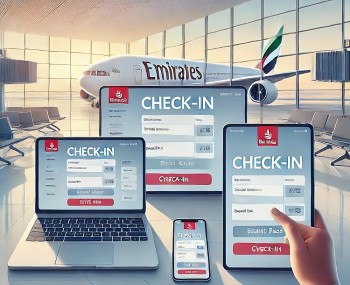Internet & Wi-fi First Invention: Inventor, Date & Time, History and Facts
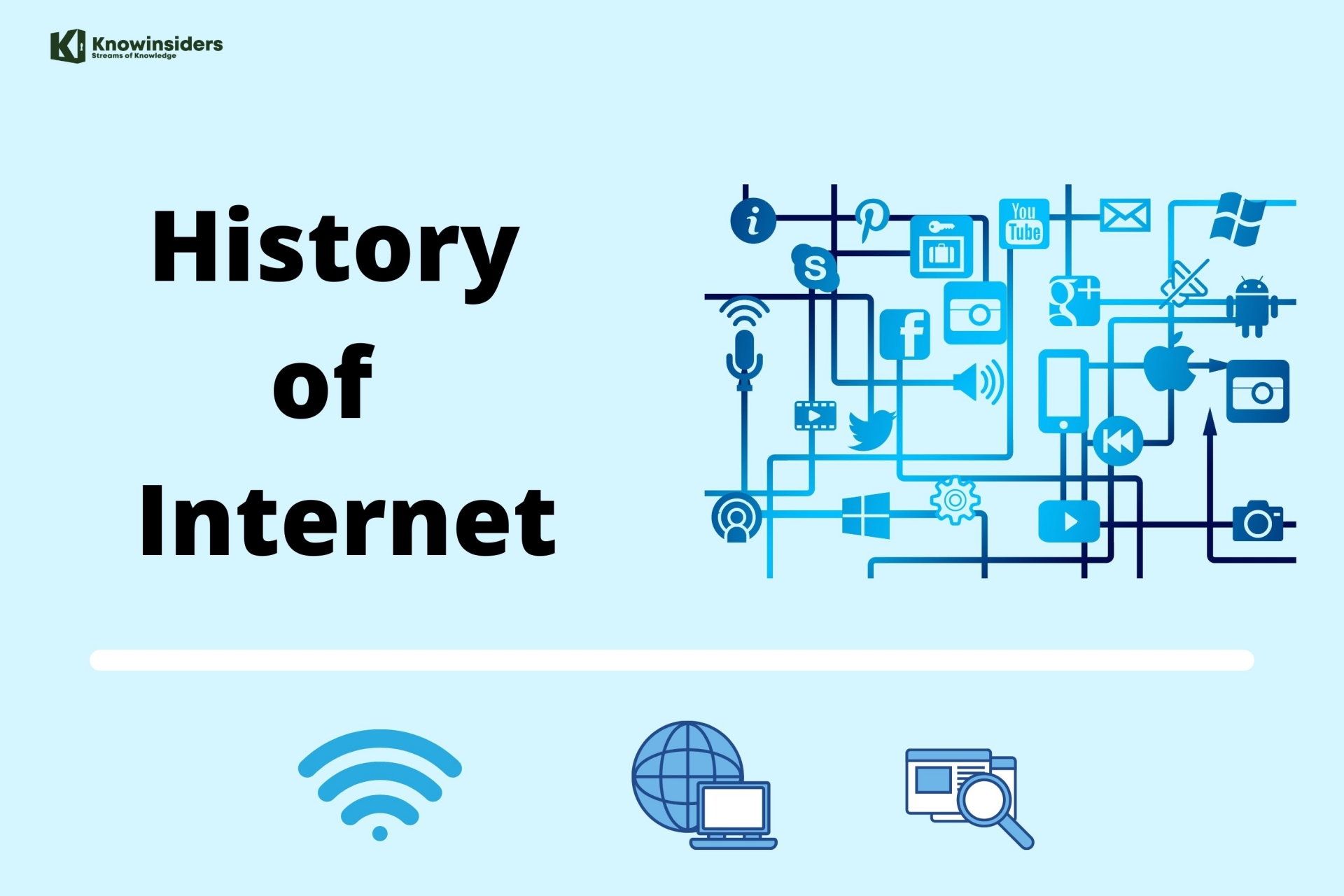 |
| Photo: KnowInsiders |
What is the Internet?
Whether it’s browsing social media, online shopping, or streaming your favorite TV shows, most of us use the Internet every day – but what is it?
In simple terms, the Internet is a system of communication between computer networks that allows information (whether it’s text, images, sound, or video) to be passed from one location to another. The Internet mainly works using a method called packet switching.
Packet switching is where data is broken down into small chunks at its source, then restored at its destination. By breaking large parts of information down into these ‘packets’, computer networks can route this data across the Internet work reliably and quickly. Any packets lost along the way can be retransmitted without having to download the whole file again.
Who invented the Internet for the first time?
No one person invented the internet. When networking technology was first developed, a number of scientists and engineers brought their research together to create the ARPANET. Later, other inventors’ creations paved the way for the web as we know it today.
• PAUL BARAN (1926–2011)
An engineer whose work overlapped with ARPA’s research. In 1959 he joined an American think tank, the RAND Corporation, and was asked to research how the US Air Force could keep control of its fleet if a nuclear attack ever happened. In 1964 Baran proposed a communication network with no central command point. If one point was destroyed, all surviving points would still be able to communicate with each other. He called this a distributed network.
• LAWRENCE ROBERTS (1937–2018)
Chief scientist at ARPA, responsible for developing computer networks. Paul Baran’s idea appealed to Roberts, and he began to work on the creation of a distributed network.
• LEONARD KLEINROCK (1934–)
An American scientist who worked towards the creation of a distributed network alongside Lawrence Roberts.
• DONALD DAVIES (1924–2000)
A British scientist who, at the same time as Roberts and Kleinrock, was developing similar technology at the National Physical Laboratory in Middlesex.
• BOB KAHN (1938–) AND VINT CERF (1943–)
American computer scientists who developed TCP/IP, the set of protocols that governs how data moves through a network. This helped the ARPANET evolve into the internet we use today. Vint Cerf is credited with the first written use of the word ‘internet’.
When asked to explain my role in the creation of the internet, I generally use the example of a city. I helped to build the roads—the infrastructure that gets things from point A to point B.
—Vint Cerf, 2007
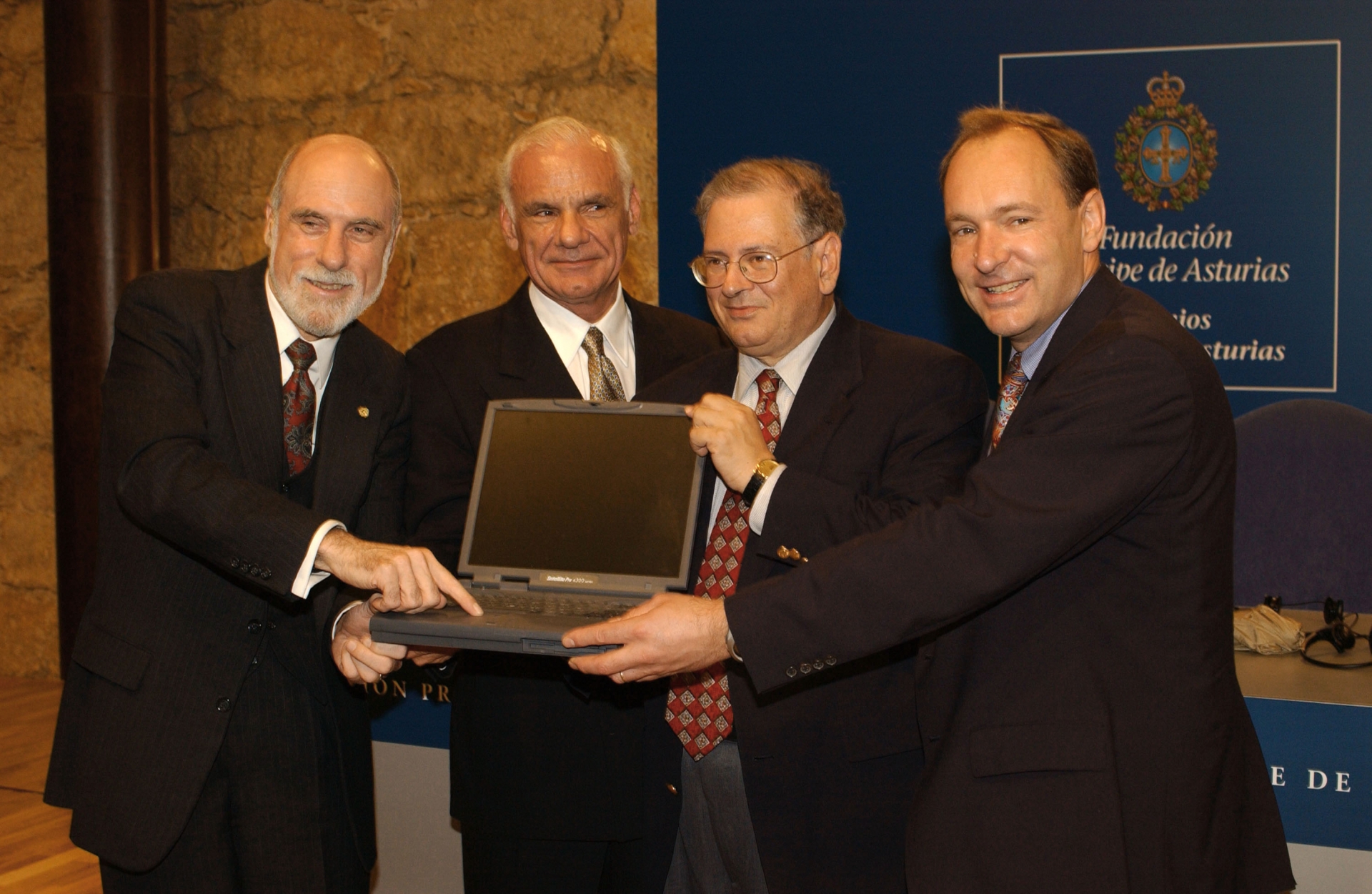 |
| Internet pioneers Lawrence Roberts, Robert Kahn, Vinton Cerf and Tim Berners-Lee attend a media conference the day before they receive the Prince of Asturias Award for Science and Technology investigation on October 24, 2002, in Oviedo, Spain.Photo: Getty Images |
• PAUL MOCKAPETRIS (1948–) AND JON POSTEL (1943–98)
Inventors of DNS, the ‘phone book of the internet’.
• TIM BERNERS-LEE (1955–)
Creator of the World Wide Web who developed many of the principles we still use today, such as HTML, HTTP, URLs and web browsers.
There was no “Eureka!” moment. It was not like the legendary apple falling on Newton’s head to demonstrate the concept of gravity. Inventing the World Wide Web involved my growing realization that there was a power in arranging ideas in an unconstrained, weblike way. And that awareness came to me through precisely that kind of process. The Web arose as the answer to an open challenge, through the swirling together of influences, ideas, and realizations from many sides.
—Tim Berners-Lee, Weaving the Web, 1999
• MARC ANDREESSEN (1971–)
Inventor of Mosaic, the first widely-used web browser.
The fathers of the Internet
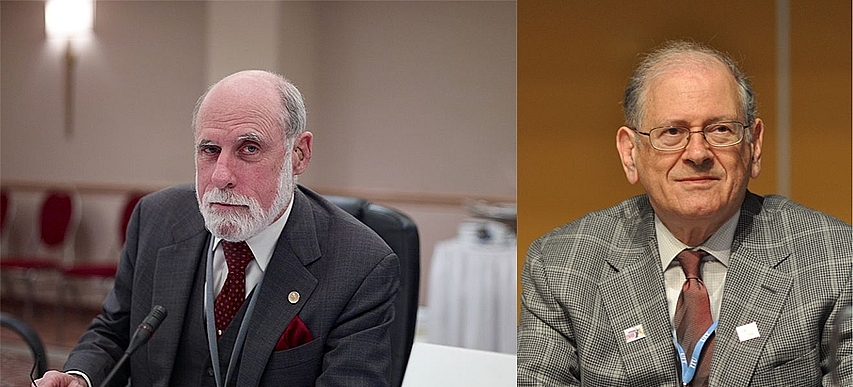 |
| Cerf and Kahn may have invented the primary protocol for the internet, but many others made valuable contributions. |
Most people consider Vinton Cerf and Robert Kahn, who designed the Transmission Control Protocol (TCP) in 1973, to be the inventors of the internet.
In 1969, the Advanced Research Projects Agency (ARPA) — the US defense department’s research branch which today is known as the Defense Advanced Research Projects Agency (DARPA) — built a computer network called ARPANet.
ARPANet linked computers at universities, government agencies, and defense contractors around the world — in many ways, it was the precursor of the Internet as we know it today. By 1975, ARPANet grew into a network spanning over 60 nodes — but let’s not get ahead of ourselves.
On September 2, 1969, the first data moved from a host at the University of California, Los Angeles (UCLA) through an interface message processor switch (a piece of network equipment). The first message sent through this precursor to the internet was delivered at 10:30 PM, October 29, 1969, by Charley Kline, a UCLA student. Kline tried to type “login” but the system only managed to transmit “lo” to a computer at the Stanford Research Institute (SRI), a couple of hundred miles away, and then crashed. This was a double world first: the first message sent over the internet and the very first server crash.
Getting networks to communicate with one another was much more challenging than networking two or more computers. Each network moved data differently, which ultimately made transferring information practically impossible. Something had to be done — and this is where two very bright ARPA researchers by the name of Robert Kahn and Vint Cerf came in.
In 1973, the pair devised a new communication architecture with a universal set of rules that essentially allowed computer networks to speak the same language.
When were the Internet and email invented?
The email was invented in 1971 by Ray Tomlinson as a method of communicating over ARPANET. However, it wasn’t until the early 1990s that email began to be used more widely, becoming one of the driving forces behind the rising popularity of the Internet.
The Internet as we know it was invented by British computer scientist Tim Berners-Lee. He founded the World Wide Web in 1991 as a method of sharing research between CERN scientists more easily. Berners-Lee invented the first web browser, server, and website – his idea was based on the concept of embedding links to other pages (hyperlinks) in the HTML of the webpage itself. His Hypertext Transfer Protocol (HTTP) and the web address (URL) are still used today.
For many years, the Internet was mainly used by government groups and scientists, but in 1995, commercial Internet access started to be sold to consumers.
| The Internet wasn’t really invented, instead, it was formed using different types of computer communication technology developed by several scientific groups. Various different internets began to connect up over time, forming the Internet we know today. |
Dial-up Internet
The first version of the Internet available for commercial use was dial-up. Dial-up Internet required a phone line to operate, so phone calls couldn’t be made using a landline while the Internet was in use.
Speed was a significant issue in the early days. By 1998, the best connection users could hope for was 56Kbps. This tiny connection speed meant that downloading a file could often become a time-consuming process, and streaming music or video wasn’t possible. Also, the earliest modems weren’t cheap with the latest 28.8Kbps modem costing up to £399 back in the early 90’s.
What is WiFi?
Wireless internet is known by different names, WiFi, wireless fidelity, and wireless LAN (wireless local area network or WLAN). WiFi stands for Wireless Fidelity. Regardless of what you call it, WiFi is a wireless networking technology that gives devices like desktop computers, laptops, mobile phones, smart TVs, game consoles, and other compatible wireless devices internet access. This allows for Bluetooth, social media, real-time streaming, and access to the limitless information that makes 2020 such a convenient time to be alive.
The first Use of Broadband and Wi-Fi
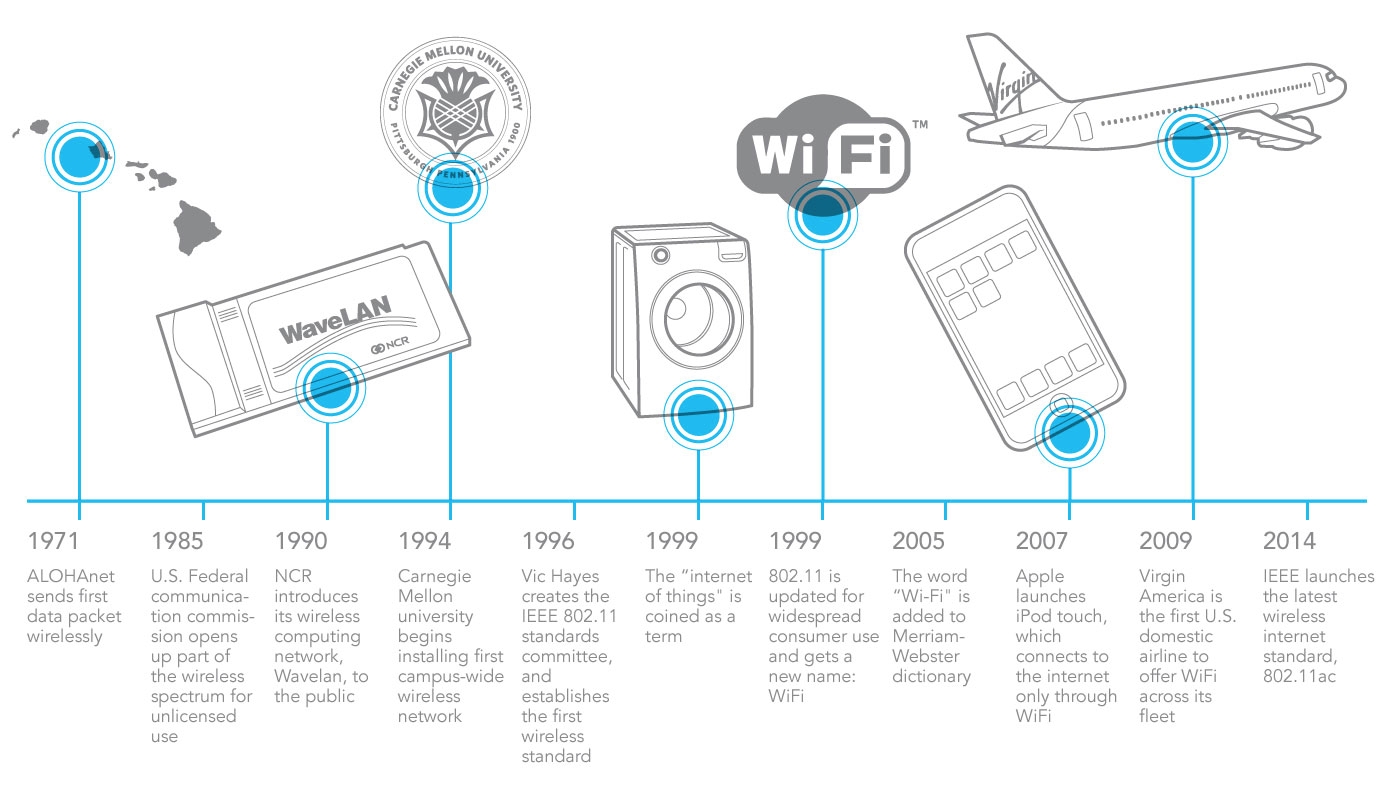 |
| Photo: eero Blog |
The next development of home browsing was the introduction of broadband and wireless Internet.
Broadband first started to replace dial-up in the early 2000s, with half of all Internet users having a broadband connection by 2007. Broadband allows a much higher volume of data to be transferred at faster speeds by using an ADSL (Asymmetric Digital Subscriber Line) connection.
Broadband also differs from dial-up as it’s always connected to the Internet, and doesn’t need to be ‘switched on’ to work.
Wireless Internet started rolling out commercially to the public in 1999, with the release of the Apple Airport, closely followed by the release of a Windows-focused Wi-Fi router in 2001. These devices quickly became the norm, replacing Ethernet cables that had to be physically plugged into a computer to work.
Wireless Internet hotspots were soon introduced at many businesses, such as coffee shops, retail stores, and offices. Wireless Internet hotspots offer the public access to the Internet, often for free, and operate using a wireless local area network (WLAN) connected to a router.
The invention of 2G, 3G, and 4G
When smartphones were initially released, early adopters had to make do with a sluggish 9.6Kbps connection, even slower than traditional home dial-up. Speeds were improved with the onset of 2G, which could reach speeds of up to 56Kbps, but mobile Internet didn’t reach its potential until the development of 3G.
This third generation of mobile Internet could reach speeds of up to 200Kbps, transforming the way we use smartphones forever. 4G was released in 2010, improving mobile Internet speeds even further to 15Mbps.
Cable broadband
Cable broadband was introduced after ADSL broadband, offering potentially faster Internet speeds by operating over cable television wires, rather than a phone line. Cable Internet speeds can fluctuate and are limited by the bandwidth allowed by the cable wire. While ADSL connections are widely accessible, cable broadband isn’t as common and is available to around half of the UK.
How is the World Wide Web different from the Internet?The terms ‘World Wide Web’ and ‘internet’ are often confused. The internet is the networking infrastructure that connects devices together, while the World Wide Web is a way of accessing information through the medium of the internet. Tim Berners-Lee first proposed the idea of a ‘web of information’ in 1989. It relied on ‘hyperlinks’ to connect documents together. Written in Hypertext Markup Language (HTML), a hyperlink can point to any other HTML page or file that sits on top of the internet. In 1990, Berners-Lee developed Hypertext Transfer Protocol (HTTP) and designed the Universal Resource Identifier (URI) system. HTTP is the language computers use to communicate HTML documents over the internet, and the URI, also known as a URL, provides a unique address where the pages can be easily found. Berners-Lee also created a piece of software that could present HTML documents in an easy-to-read format. He called this ‘browser’ the ‘WorldWideWeb’. On 6 August 1991 the code to create more web pages and the software to view them was made freely available on the internet. Computer enthusiasts around the world began setting up their own websites. Berners-Lee’s vision of a free, global and shared information space began to take shape. |
The Introduction of Web Browsers
 |
| Photo: Good Art & Design |
Tim Berners-Lee was the first to create a piece of software that could present HTML documents in an easy-to-read format. He called this ‘browser’ the ‘WorldWideWeb’. However, this original application had limited use as it could only be used on advanced NeXT machines. A simplified version that could run on any computer was created by Nicola Pellow, a maths student who worked alongside Berners-Lee at CERN.
In 1993, Marc Andreessen, an American student in Illinois, launched a new browser called Mosaic. Created at the National Center for Super-computing Applications (NCSA), Mosaic was easy to download and install, worked on many different computers and provided simple point-and-click access to the World Wide Web. Mosaic was also the first browser to display images next to text, rather than in a separate window.
Mosaic’s simplicity opened the web up to a new audience, and caused an explosion of activity on the internet, with the number of websites growing from 130 in 1993 to over 100,000 at the start of 1996.
In 1994 Andreesen formed Netscape Communications with entrepreneur Jim Clark. They led the company to create Netscape Navigator, a widely used internet browser that at the time was faster and more sophisticated than any of the competition. By 1995, Navigator had around 10 million global users.
21 interesting facts about the Internet
#1 – a single Google query uses 1,000 computers in 0.2 seconds to retrieve an answer
#2 – the term SURFING the internet was coined in 1992 by New York librarian Jean Armor Polly aka Net Mom
#3 – Twitter has over 250 million users
#4 – the original Space Jam website is still alive (http://www2.warnerbros.com/spacejam/movie/jam.htm)
#5 – 16 – 20% of the searches Google gets each day have never been Googled before
#6 – the “You’ve Got Mail!” website is still online (http://youvegotmail.warnerbros.com/)
#7 – the most popular Tumblr is the official updates page of Minecraft
#8 – the most expensive keyword for Google Adwords is “Insurance” – $54.91 Cost-Per-Click (according to WordStream)
#9 – the Amazon logo indicates you can get everything from A to Z
# 10 – the first Spam Email was sent in 1978 over APARNET by a guy named Gary Thuerk
#11 – 1 million babies have been born from people who met on Match.com
#12 – 2.58 million people still pay for AOL
#13 – Sina Weibo has 280.8 million users
#14 – the 1st tweet was sent on March 21, 2006
#15 – the first registered domain was symbolics.com
#16 – 500 million tweets are sent every day
#17 – Tila Tequila had 1.5 million friends on MySpace
#18 – the world record of the fastest time to log into Gmail is 1.16
#19 – Mark Zuckerberg’s original Facebook profile number ID is 4
#20 – the first website is still online (http://info.cern.ch/hypertext/WWW/TheProject.html)
#21 – today the Internet is 8478 days old
 When Was The First Computer Invented and Who Invented? When Was The First Computer Invented and Who Invented? The computer is a modern device and popular nowadays! But, have you ever thought about when was the first computer invented and who invented it. |
 Top 10 Weirdest and Craziest Inventions of All Time Top 10 Weirdest and Craziest Inventions of All Time These are some of the strangest human inventions. Have you ever wondered what is the weirdest invention ever? Now, check out the list of the ... |
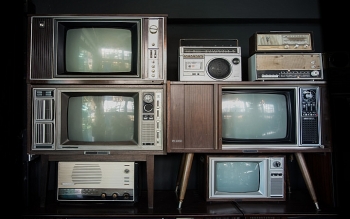 What is the first television in the world and who invented it? What is the first television in the world and who invented it? Evidently, television is one of the historic inventions in the world that allows us to get access to the information easily and conveniently. It takes ... |























